As your Shopify store grows, so do your questions:
Which campaigns are actually driving revenue?
What’s the lifetime value of a customer by channel?
Why don’t the numbers in Google Analytics match Shopify’s reports?
Shopify’s built-in analytics can only take you so far. For merchants who need advanced reporting, flexible segmentation, or unified attribution, the next step often involves sending their store data to a more powerful system — like Google BigQuery.
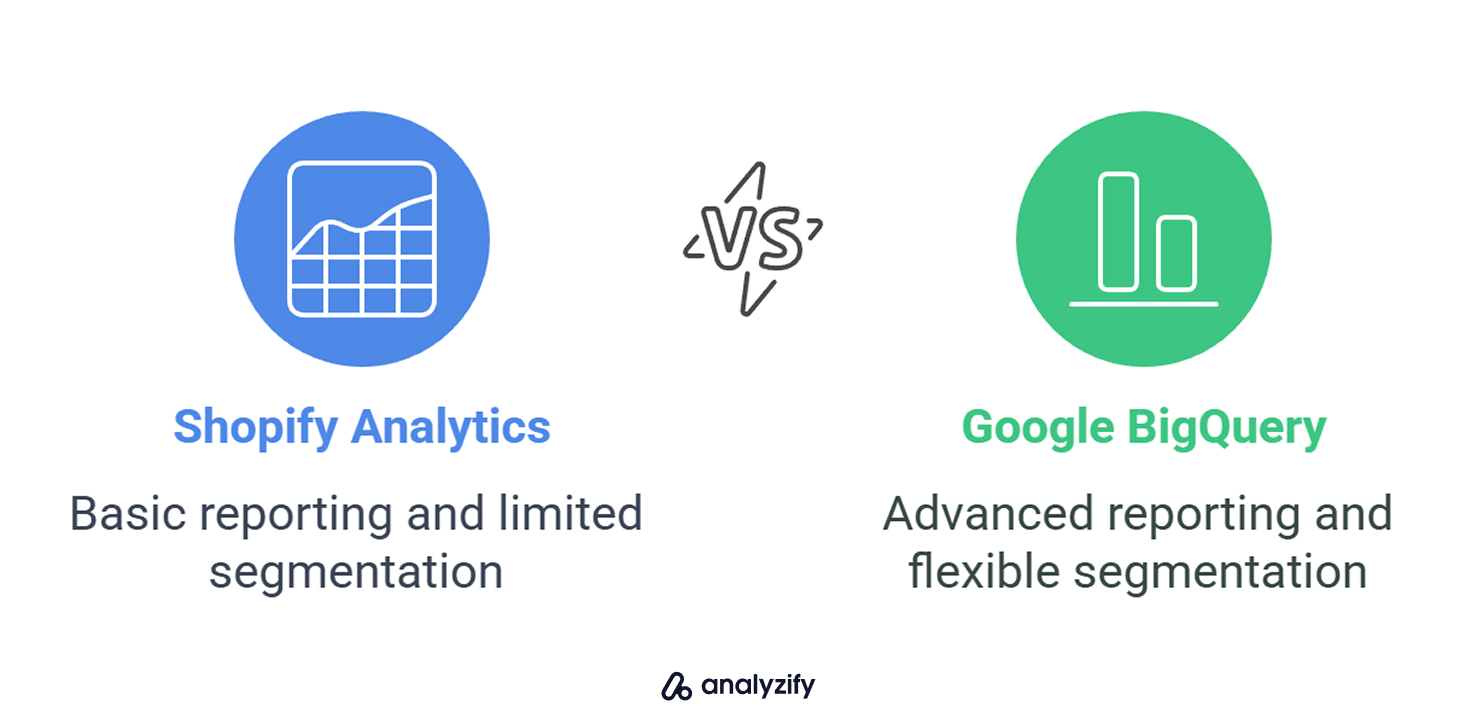
BigQuery is a cloud-based data warehouse that makes it possible to run fast, complex queries on massive datasets — with direct connections to Google Ads, GA4, and Looker Studio. For Shopify merchants, it offers a scalable, flexible foundation for building a truly customized analytics stack.
Here’s what you’ll find in this guide:
Why BigQuery is a strong fit for Shopify analytics
What makes this integration technically challenging
How to move your Shopify data into BigQuery (step-by-step)
What tools or services can help — including Shopify-focused options
Let’s start with the why.
Why Use BigQuery with Shopify?
Shopify makes it easy to start selling — but as your brand grows, so does the complexity of your data. Most fast-growing merchants hit the same wall: the built-in reports don’t answer the deeper questions your team starts asking.
BigQuery helps solve that.
It’s a serverless data warehouse built by Google, designed for fast querying, large-scale storage, and integration with the rest of the Google ecosystem (GA4, Google Ads, Looker Studio, etc.).
When used with Shopify, it gives you full ownership and flexibility over your store’s raw data — something you can’t get from the Shopify dashboard or third-party apps alone.
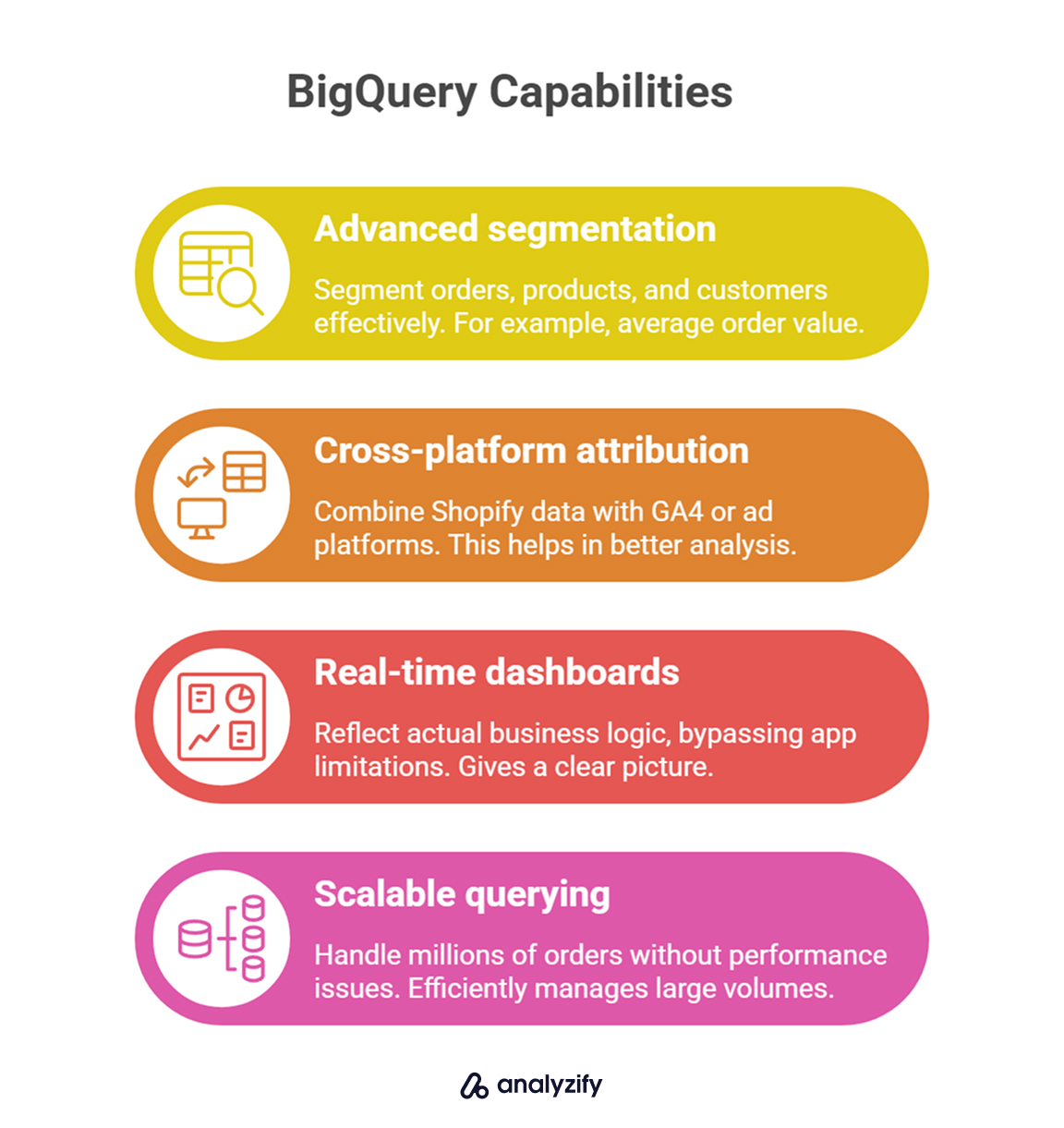 Here’s what BigQuery enables that Shopify can’t:
Here’s what BigQuery enables that Shopify can’t:
Advanced segmentation across orders, products, and customers
(e.g. “Average order value by product tag and campaign UTM”)Cross-platform attribution by combining Shopify with GA4 or ad platform data
Real-time dashboards that reflect your actual business logic — not app limitations
Scalable querying even as your order volume grows into the millions
For data teams, BigQuery also unlocks the ability to run SQL queries, build predictive models, and connect to business intelligence tools without hitting the limits of Shopify’s admin panel.
If your marketing or finance team has ever asked,
“Can we break this down by region, product type, and discount usage — but only for new customers?” then BigQuery is the type of tool you need.
Why Connecting Shopify to BigQuery Isn’t Simple
BigQuery is a powerful destination for analytics — but getting your Shopify data into it isn’t straightforward. Shopify doesn’t provide a built-in way to connect to BigQuery, and the process requires navigating some non-obvious technical hurdles.
Here’s what makes this harder than it looks:
Shopify’s Data Isn’t Table-Ready
Shopify structures its data in nested JSON format. For example, a single order contains:

Multiple line items (products)
Applied discounts (can be stacked or tiered)
Fulfillment statuses
Buyer notes, attributes, and tags
You can’t just export a CSV and upload it to BigQuery. You’ll need to split these into multiple tables (e.g., Orders, Line Items, Discounts) and define relationships between them — just like a mini database schema. Otherwise, even simple questions like “How many units did we sell by product type?” become hard to answer.
Marketing Attribution Data Isn’t Stored Automatically
Shopify doesn’t retain tracking parameters like UTM source/medium, GCLID (Google Ads), or FBCLID (Meta Ads) unless you customize your theme or checkout to store them manually. Without this, you won’t be able to attribute sales to campaigns when analyzing in BigQuery.
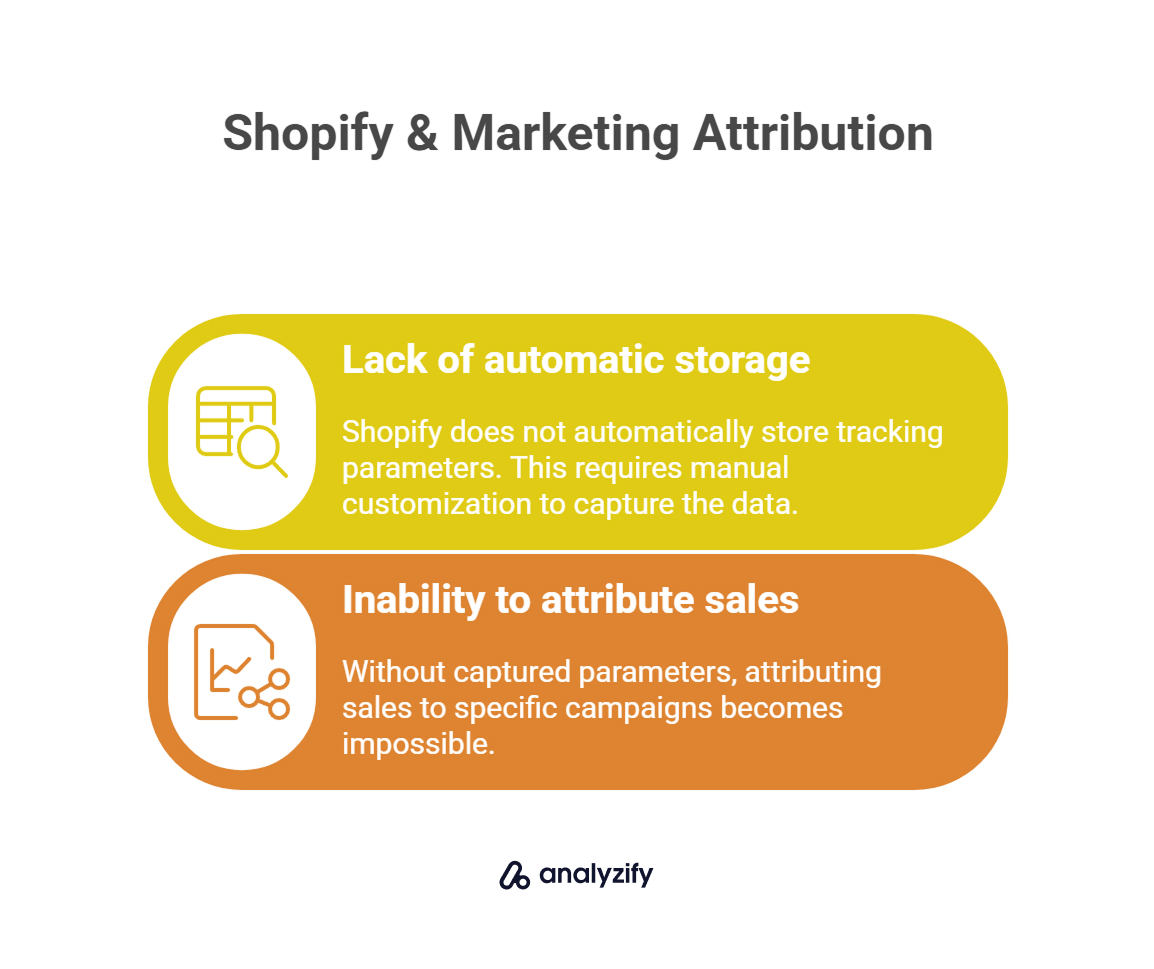
For example:
You may know that a customer placed an order.
But you won’t know whether they came from a Meta ad, Google search, or email — unless you’ve captured those parameters during their session.
No Official Shopify–BigQuery Integration
Unlike tools like GA4 or Klaviyo, there’s no official connector or “Export to BigQuery” button in Shopify. You’ll need to:
Use the Shopify Admin API to extract structured data
Optionally listen to webhooks for real-time updates
Transform the data so it’s compatible with BigQuery (flattened, schema-mapped)
Load it using BigQuery APIs or services like Cloud Functions / Composer
Each of these steps requires configuration, scripting, and sometimes rate limit handling.
Manual Pipelines = Manual Maintenance
Even if you build a pipeline once, you’ll need to maintain it:
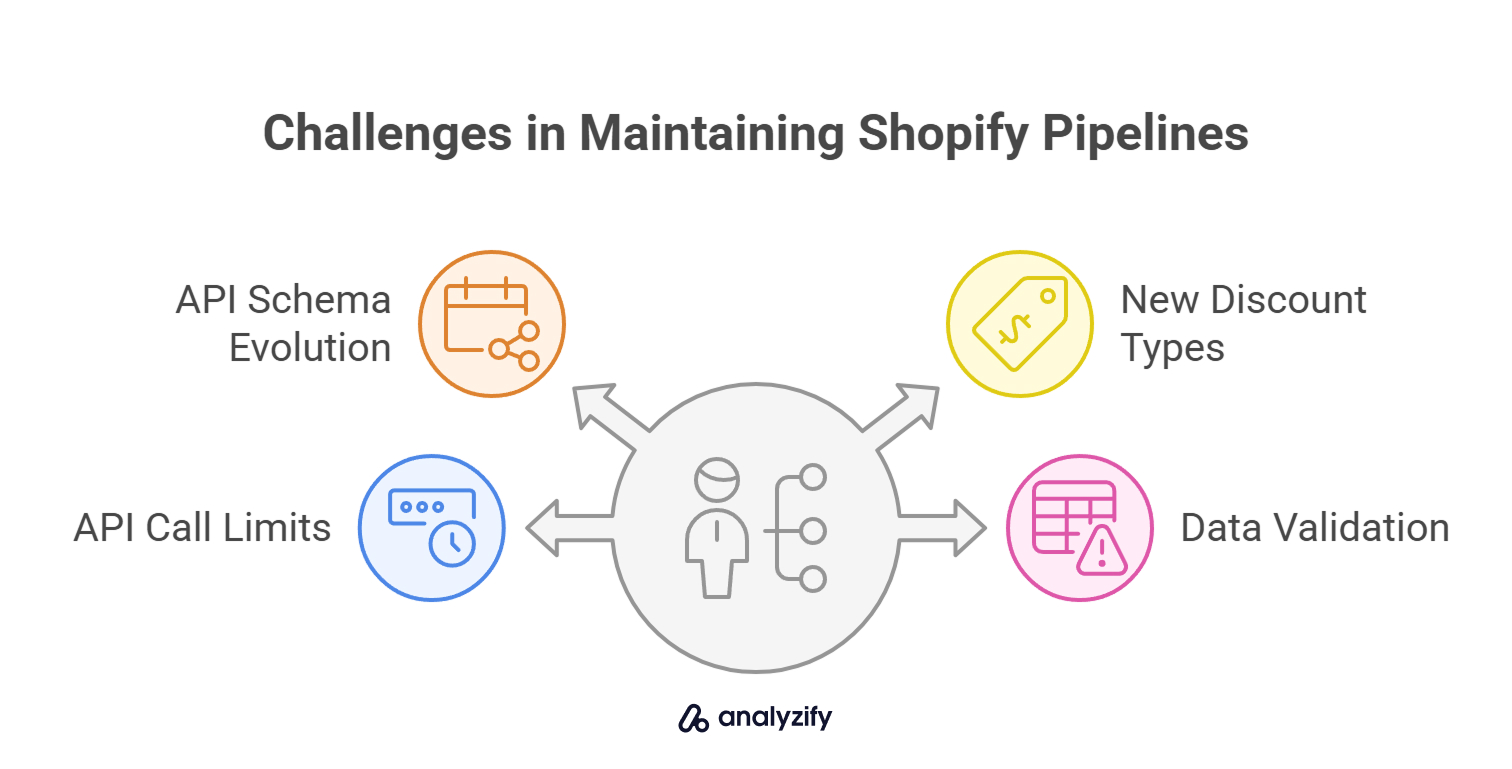
Shopify’s API schema evolves every quarter
New discount types, order flags, custom additional parameter or fulfillment options can break your logic
API call limits can delay or interrupt your syncs
Data validation and error alerts must be set up to avoid broken dashboards
This is where many merchants struggle — especially when scaling.
How to Load Shopify Data into BigQuery (Options Breakdown)
There are three main ways to send your Shopify data to BigQuery. Each comes with trade-offs in control, complexity, and reliability. Here’s how they compare:
✅ Option 1: Build a Custom ETL Pipeline
In this setup, your team builds the entire pipeline using Shopify’s Admin API, webhook events, and Google Cloud services like Cloud Functions or Composer. You extract raw data from Shopify, convert it into a clean, flattened format, and then load it into BigQuery using the BigQuery API.
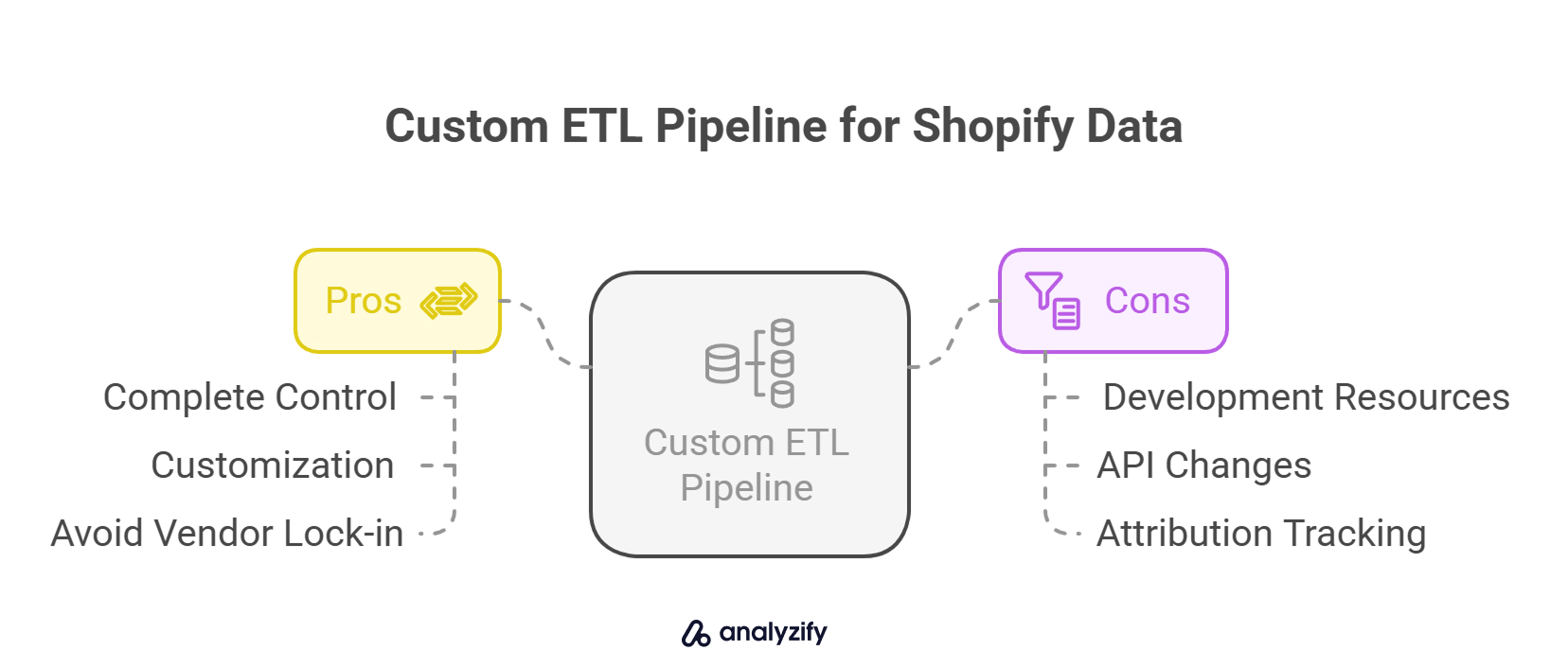
Pros:
You have complete control over what data is extracted and how it’s structured.
You can fully customize the pipeline to meet your specific reporting needs.
You avoid vendor lock-in and third-party pricing.
Cons:
Building and maintaining this pipeline requires strong development resources.
Any changes in Shopify’s API may require quick updates to your code.
Attribution tracking must be built from scratch, including capturing UTM and GCLID values during checkout.
Bonus: A Step-By-Step Look at ETL for Shopify Stores
✅ Option 2: Use a General-Purpose ETL Tool
Popular ETL platforms like Fivetran, Airbyte, and Stitch offer prebuilt connectors for Shopify and BigQuery. These tools let you sync data from one platform to the other with a few clicks and minimal configuration.
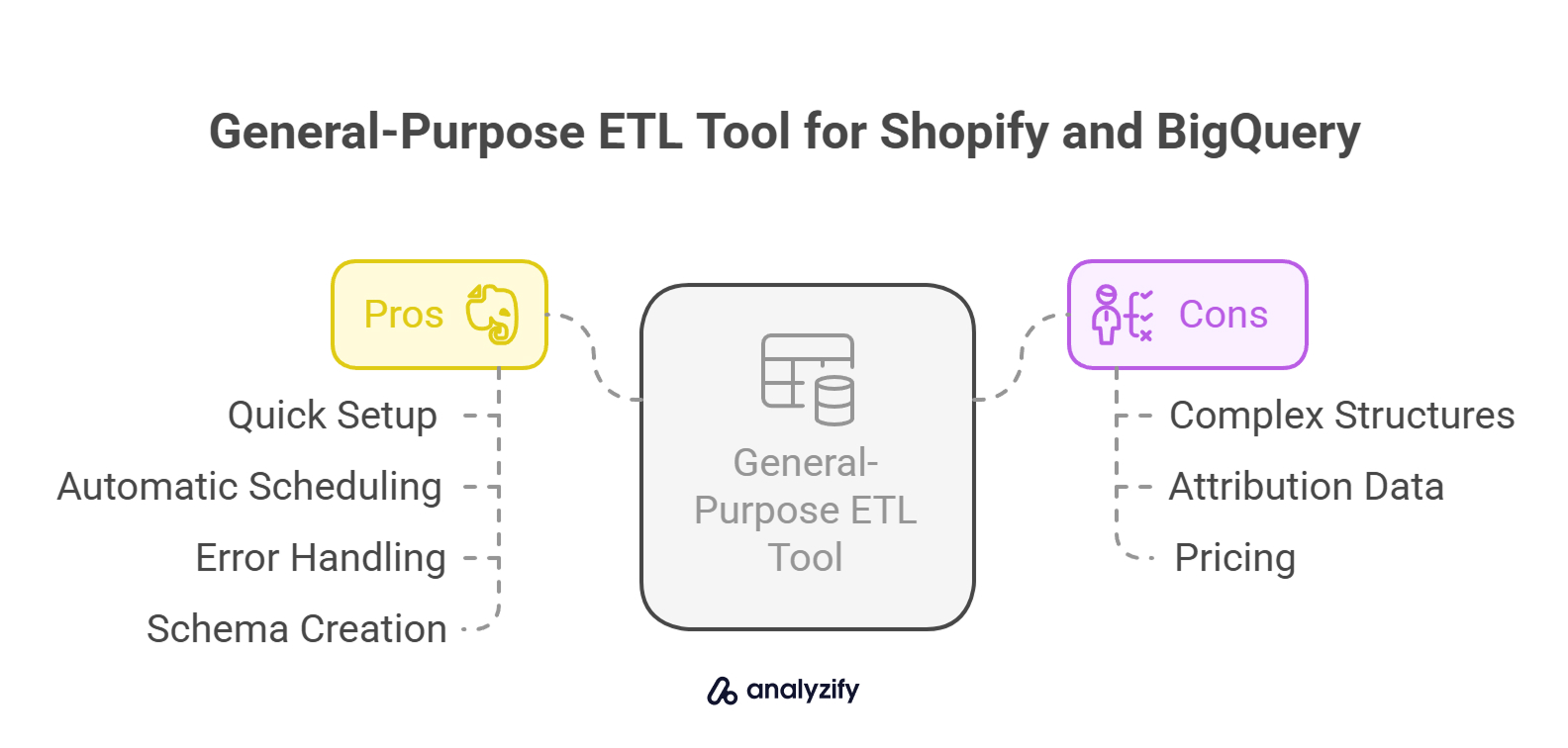
Pros:
You can set up your pipeline quickly without writing any code.
Most tools offer automatic scheduling, error handling, and schema creation.
Ideal for teams who want a simple solution without heavy technical involvement.
Cons:
These tools may not handle Shopify’s complex structures, such as nested line items, multi-level discounts, or custom order properties.
Attribution data like UTM parameters is not captured unless you manage it separately.
Pricing often scales with row volume, which can become expensive over time.
✅ Option 3: Use a Shopify-Specific ETL Solution (e.g., Analyzify)
Shopify-focused ETL tools like Analyzify are purpose-built for the platform’s unique data model. These solutions extract, transform, and load Shopify data into BigQuery in a way that’s optimized for ecommerce reporting — including attribution and session tracking.
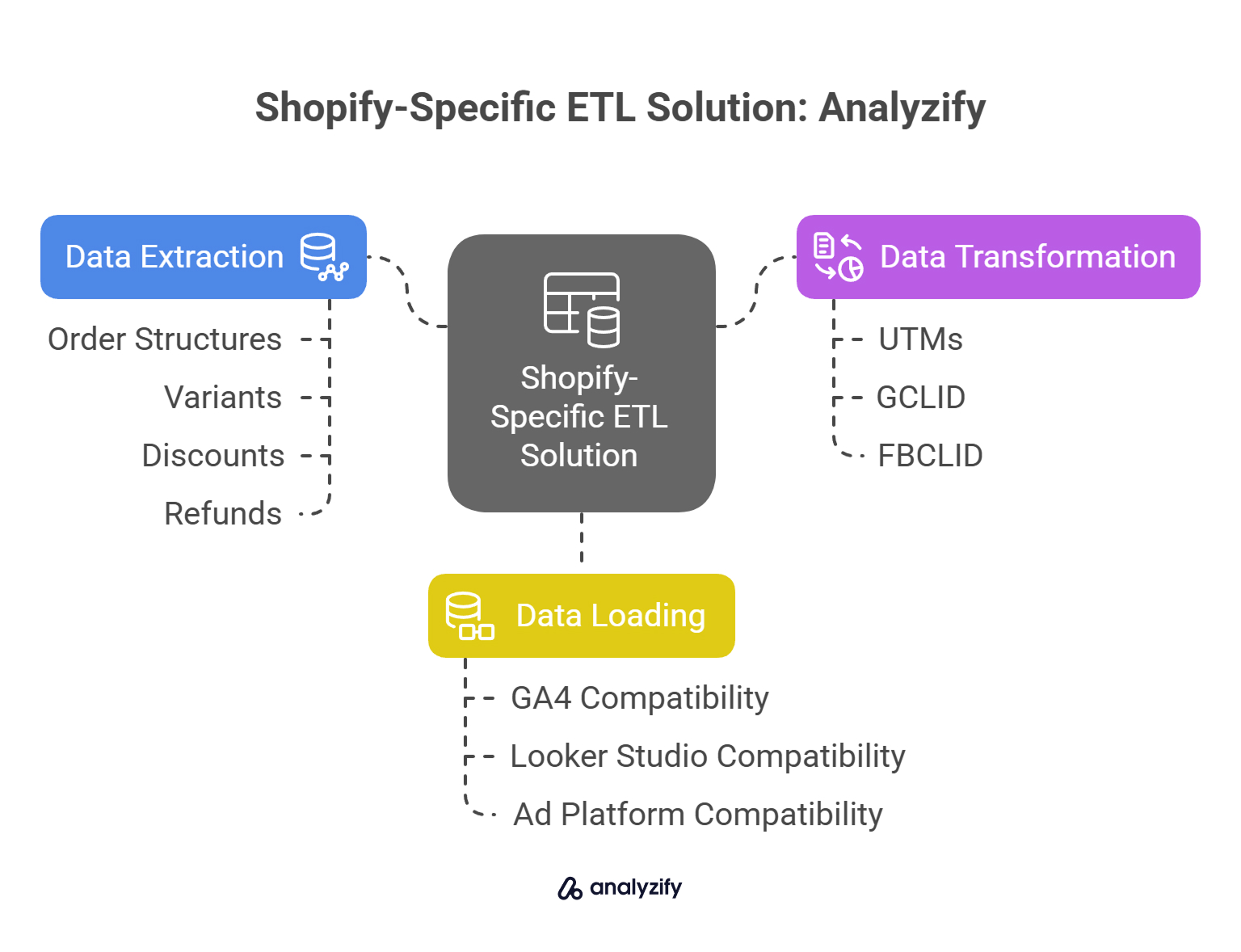
Handles complex order structures, variants, discounts, and refunds natively.
Captures UTMs, GCLID, and FBCLID automatically if implemented correctly.
Output is reporting-ready and compatible with GA4, Looker Studio, and ad platforms.
Eliminates the need for custom scripting or maintaining infrastructure.
Bonus: Top 10 Shopify ETL Tools For Ecommerce Data (2025)
What Analyzify Can Provide in Custom BigQuery Setups
If your team wants the power of BigQuery without the complexity of building and maintaining a custom data pipeline, Analyzify offers a structured solution built specifically for Shopify merchants.
We’ve already implemented this kind of setup for advanced use cases where Shopify data needed to flow reliably into BigQuery and fuel custom reporting, attribution analysis, and business intelligence tools.
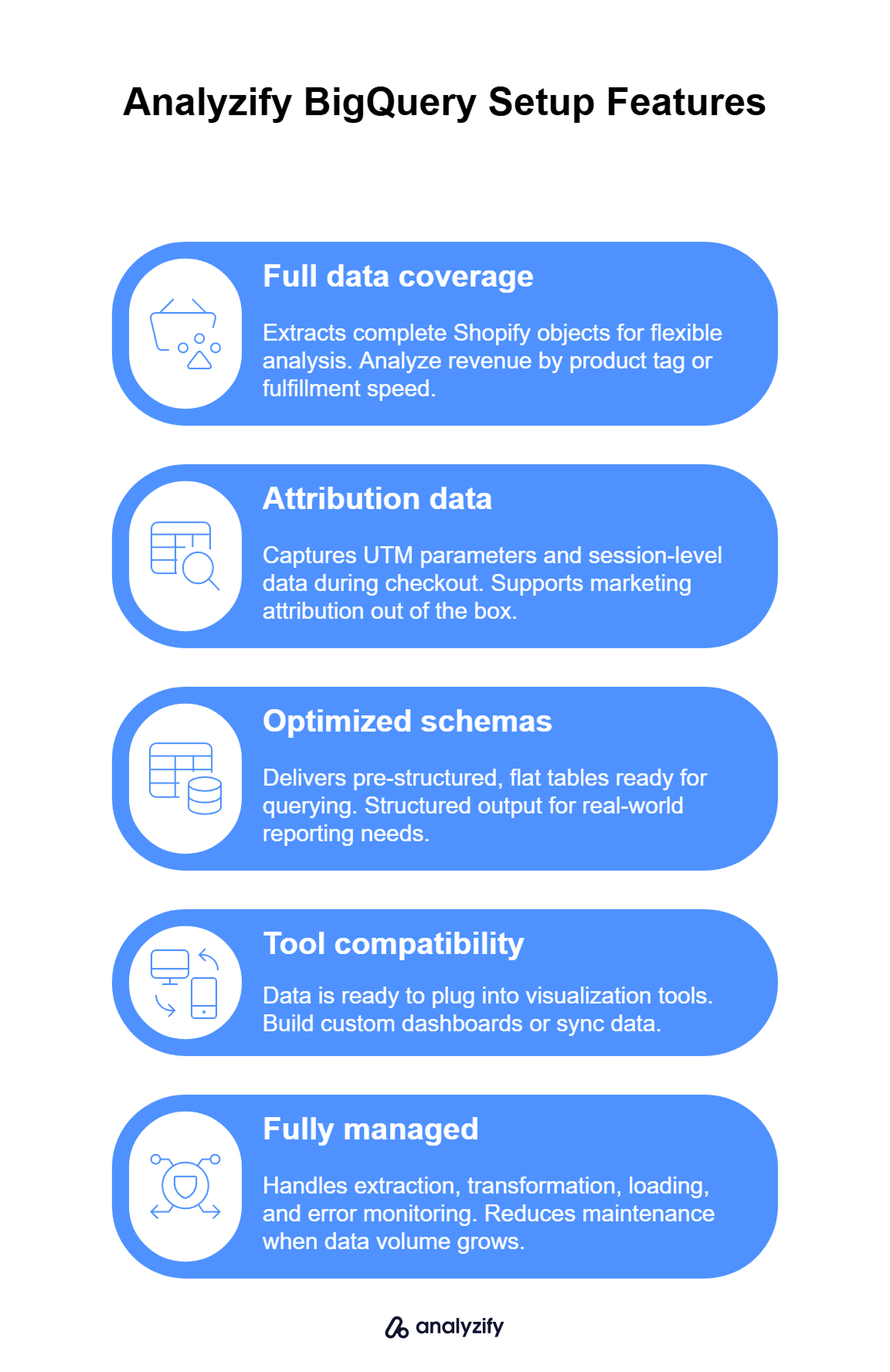
Here’s what Analyzify provides in these scenarios:
Full ecommerce data coverage: We extract complete Shopify objects, including orders, line items, products, customers, refunds, and draft orders. This gives you the flexibility to analyze anything from revenue by product tag to fulfillment speed by vendor.
Attribution data included: Our setup captures and stores UTM parameters, GCLID (Google Ads), FBCLID (Meta), and other session-level data during checkout. This ensures your BigQuery data supports marketing attribution out of the box.
Clean, BigQuery-optimized schemas: We deliver pre-structured, flat tables that are ready for querying. You don’t need to worry about flattening Shopify’s JSON or mapping nested fields — the output is structured for real-world reporting.
GA4, Looker Studio, and ad platform compatibility: We ensure the data you receive is ready to plug into visualization or ad tools. Whether you’re building custom dashboards or syncing data back to ad platforms for conversions, your schema will be aligned.
Low maintenance, fully managed: Our team handles the extraction, transformation, loading, and ongoing error monitoring — so you’re not on the hook when Shopify’s API changes or your data volume grows.
This setup is ideal for merchants who want full data ownership, advanced reporting capabilities, and a scalable analytics stack — without taking on the cost and complexity of managing it all internally.
Bonus: How to Connect Shopify to ClickHouse (and Why You Might Want To)
✅ Want to Connect Shopify to BigQuery— Without Building It Yourself?
We can help. Reach out to explore a custom Shopify → BigQuery setup that fits your stack, goals, and data needs.
 Built for Shopify · Query-Ready Data · No Code Required
Built for Shopify · Query-Ready Data · No Code Required Connect Shopify to BigQuery — No Code, No Complex Setup.
Analyzify connects your Shopify data to BigQuery with full attribution, clean schemas, and no manual setup.Is BigQuery the Right Fit for Your Shopify Brand?
BigQuery isn’t for everyone — but for the right Shopify teams, it unlocks a level of data access and reporting that simply isn’t possible through the Shopify dashboard, GA4, or third-party analytics apps.
If your brand is growing fast, running multi-channel campaigns, or struggling to get clear answers from siloed reports, BigQuery offers a future-proof foundation to build on.
It’s especially useful if:
You want to run advanced segmentation or LTV models across large datasets.
You need to unify marketing data, order events, and customer profiles in one place.
You already use GA4, Google Ads, or Looker — and want your Shopify data to plug in directly.
That said, setting it up right takes more than exporting a few CSVs. Between Shopify’s complex structure and the need for attribution accuracy, most teams benefit from a structured ETL solution — whether it’s custom-built or managed through a provider like Analyzify.
When done properly, BigQuery doesn’t just store your data — it gives you back control over how your business is measured.

































